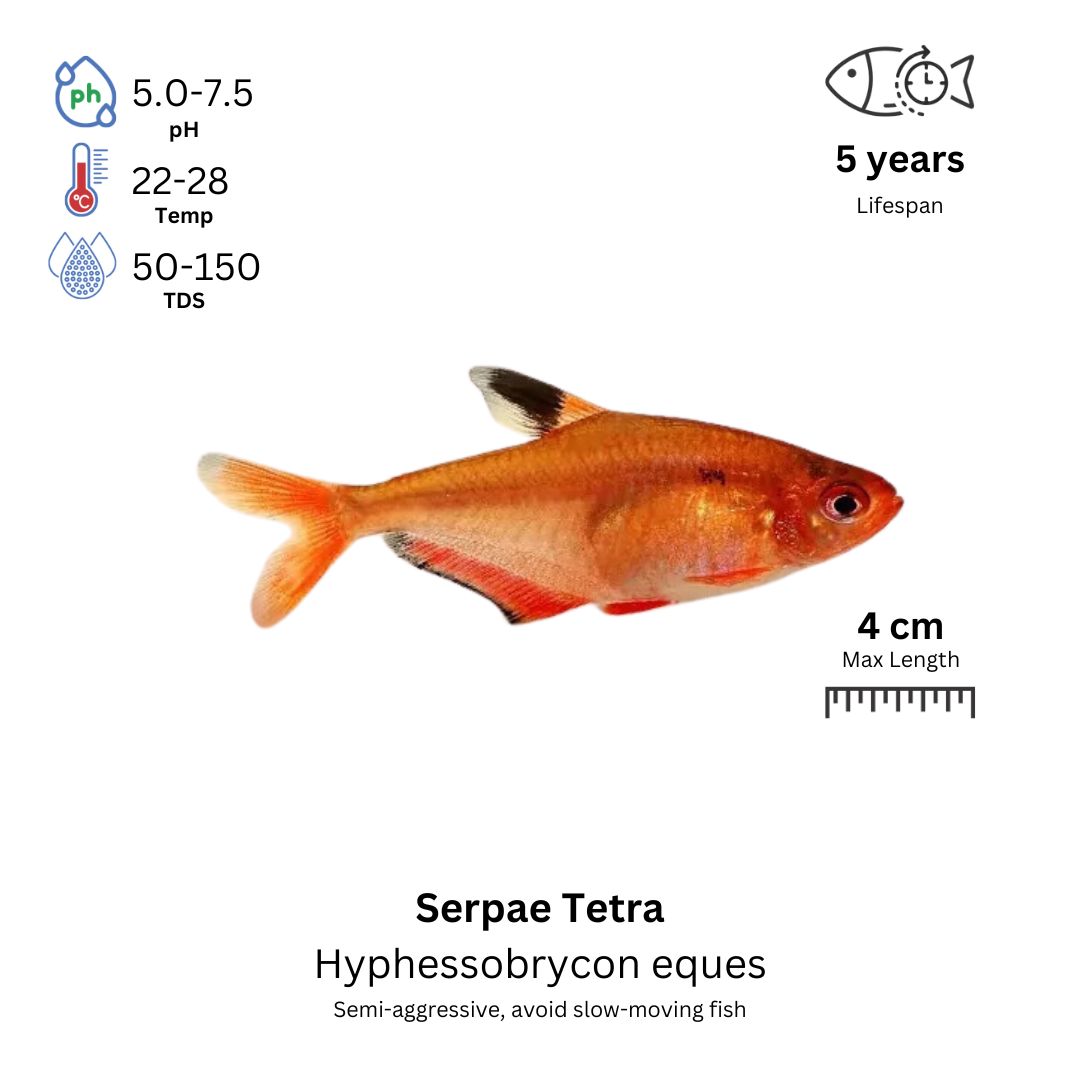Serpae Tetra: Species Profile
The Serpae Tetra (Hyphessobrycon eques), also known as the Red Minor Tetra, is a vibrant freshwater fish admired for its striking red coloration and dynamic behavior. Originating from the Amazon River basin in South America, this species is a popular choice among aquarists due to its hardiness and lively presence in community tanks.
Species Overview
- Common Names: Serpae Tetra, Red Minor Tetra, Jewel Tetra
- Scientific Name: Hyphessobrycon eques
- Adult Size: Approximately 1.5 inches (4 cm)
- Life Expectancy: 5 to 7 years
Characteristics
- Family: Characidae
- Origin: Amazon River basin, South America
- Social: Peaceful, schooling
- Tank Level: Midwater
- Minimum Tank Size: 20 gallons
- Diet: Omnivore
- Breeding: Egglayer; moderately challenging in captivity
- Care Level: Beginner
- pH: 5.0 to 7.8
- Hardness: 5 to 25 dGH
- Temperature: 72–79°F (22–26°C)
Origin and Distribution
Serpae Tetras are native to the Amazon River basin, inhabiting slow-moving rivers, streams, and floodplains rich in vegetation. They thrive in warm, soft, and slightly acidic waters, often found in areas with dense plant life and submerged roots.
Colors and Markings
This species is characterized by a deep red body adorned with a distinctive black comma-shaped mark behind the gills. The dorsal fin is predominantly black with a white edging, while the other fins are red, sometimes with black or white tips. Males typically exhibit more intense coloration compared to females.
Tankmates
Serpae Tetras are generally peaceful but can display fin-nipping behavior, especially if kept in insufficient numbers. To minimize this, maintain a school of at least six individuals. Suitable tankmates include:
- Other small tetras
- Rasboras
- Corydoras catfish
- Dwarf gouramis
- Livebearers like guppies and platies
Avoid housing them with long-finned or slow-moving species, such as bettas or angelfish, to prevent potential fin-nipping.
Habitat and Care
To replicate their natural habitat:
- Tank Setup: Provide a well-planted aquarium with open swimming areas. Incorporate fine-leaved plants, driftwood, and rocks to offer hiding spots and mimic their natural environment.
- Water Parameters: Maintain stable water conditions within the recommended pH and hardness ranges. Regular water changes are essential to keep the environment clean and healthy.
- Lighting: Moderate lighting is preferred, which can be achieved with floating plants to diffuse light.
Diet and Feeding
Serpae Tetras are omnivorous and thrive on a varied diet:
- High-quality flake or micro-pellet food
- Live or frozen foods such as brine shrimp, daphnia, and bloodworms
- Occasional vegetable matter like blanched spinach or zucchini
Feed them small portions multiple times daily, ensuring they consume the food within a few minutes to prevent overfeeding and maintain water quality.
Gender Differences
Males are generally more colorful with a slimmer body, while females have a rounder abdomen, especially when carrying eggs.
Breeding
Breeding Serpae Tetras in captivity is moderately challenging:
- Breeding Tank: Set up a separate tank with fine-leaved plants or spawning mops. Maintain slightly acidic to neutral water with a temperature around 78°F (26°C).
- Spawning: Introduce a conditioned male and female pair. Spawning typically occurs in the early morning, with the female scattering eggs that the male fertilizes.
- Raising Fry: After spawning, remove the adults to prevent them from eating the eggs. Eggs hatch within 24–36 hours, and fry can be fed infusoria or commercially prepared fry food until they are large enough to accept standard foods.
Further Research
For those interested in similar species, consider exploring:
- Ember Tetra (Hyphessobrycon amandae)
- Neon Tetra (Paracheirodon innesi)
- Glowlight Tetra (Hemigrammus erythrozonus)
These species share comparable care requirements and can coexist harmoniously in a community aquarium.
FAQ
- How many Serpae Tetras should be kept together? It’s best to keep them in groups of at least six to promote natural schooling behavior and reduce stress.
- Are Serpae Tetras suitable for beginners? Yes, their hardy nature and ease of care make them excellent choices for novice aquarists.
- Can Serpae Tetras live with other fish? Yes, they can coexist with other peaceful, similarly sized fish. However, avoid housing them with long-finned or slow-moving species to prevent potential fin-nipping.
By providing appropriate care and a suitable environment, Serpae Tetras can be a lively and colorful addition to any freshwater aquarium.



Reviews
There are no reviews yet.